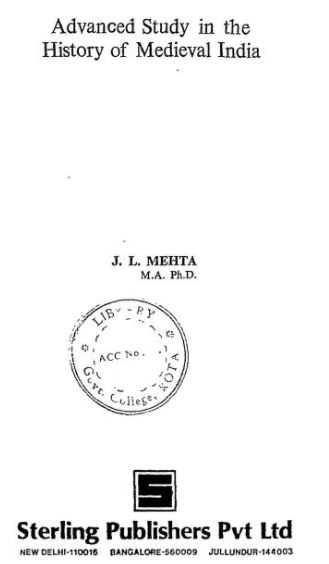‘J l Mehta Medieval History’ PDF Quick download link is given at the bottom of this article. You can see the PDF demo, size of the PDF, page numbers, and direct download Free PDF of ‘J l Mehta Medieval Histor’ using the download button.
Advanced Study In The History Of Medieval India PDF Free Download

J l Mehta Medieval Histor
Indian Historiography-an Islamic Heritage
Ancient Indians had no taste for historiography; their scholars cared more for religious, spiritual, and philosophical studies.
Indian historiography is essentially an Islamic heritage; it was the Muslim ulama and chroniclers who showed a keen sense of history and wrote detailed accounts of the day-to-day happenings and political upheavals.
Their primary object in doing so was, of course, the glory of Islam; they took pride in the military exploits of an amir ul hominin.
Who attempted to transform dar ul haram into dar ul Islam by the conversion of ‘infidels’ to the faith. Even otherwise, they were men of this world.
Who valued their material possessions and strove hard to multiply their worldly gains; this instinct helped them in keeping track of the events, past, and present.
The Muslim monarchs employed chroniclers, diarists, and court historians who maintained profuse records of their activities, very often in systematic and chronological order, though usually exaggerated.
The scholars produced books and poets composed masnavis on the dynastic, regional, or general histories of the Islamic earlier literary records of the Muslim chroniclers are found in Arabic.
The language of the Quran, and the Arab quiet. With the establishment of Islam in Persia, there took place a revival of Persian nationalism within the Muslim world.
It resulted in the adoption of the Persian language and culture by the Turkish dynasties, founded mostly by the slave officers of the Persian monarchs.
Consequently, along with the establishment of the Turkish rule was planted the Persian tradition of historiography in Indin.
Most of these literary records are thus found in Persian though some works are in Arabic and other languages like Turki have also come down to us.
These days we get translations in English and Indian languages of many an important work; the others are rapidly being translated and edited by the scholars.
The Conquests of Qutubuddin Aibek
Qutubuddin Aibek faced numerous revolts and other difficulties in maintaining Tiis hold over the newly acquired territories in the Gangetic valley.
He not only suppressed these revolts with an iron hand but also expanded the boundaries of his dominions. The credit for the conquest of Ajmer, Kanauj and Kalinjar from 1 195 to 1203 goes to him.
The Dor Rajputs of Koil (Aligarh) revolted but were suppressed with ease. Benaras and its adjoining territories were lost to the Gahadavallas of Kanauj.
Hari Rai Chauhan acquired control of Ajmer from his nephew Govind Raja and re-established himself as an independent ruler. He sent an army to liberate Delhi.
Aibek intercepted it near Ajmer itself and compelled it to retreat to the fort, which was promptly besieged by the Turks. The Rajput desperadoes offered a dogged resistance and perished to a man in the struggle; their chief Hari Rai performed jauhar and ended his life instead of falling into the hands of the Turks.
The conquest of Ajmer was a great achievement of Qutubuddin Aibek. He appointed a Turkish governor with a strong military force at Ajmer.
Muhammad Ghori brought a fresh army from Ghazni in 1195-96 to reinforce his Indian garrisons. It was placed at the disposal of Qutubuddin Aibek. Bayana was conquered (1196 a.d.) and put under the charge of a Turkish noble.
Gwalior was besieged but its Rajput chief Sulakshana Paul held out and, ultimately, got rid of the Turks by the offer of a nominal submission. The Turkish governor of Bayana, however, continued to exert pressure upon Gwalior which was conquered by him between 1197-1200.
The Chauhan inhabitants of the Ajmer region did not reconcile themselves to the loss of Ajmer, once their imperial seat of governance. They made yet another effort to liberate it with the help of the Merh Rajputs of Malwa and the Chalukya volunteers from Anhilwara.
They defeated the Turkish garrison of Ajmer. When Aibek rushed to its support, he was also defeated and obliged to seek shelter within the fort. The chance arrival of a fresh contingent from Ghazni, however, compelled the Rajputs to raise the siege,
Qutubuddin Aibek retaliated by invading Anhilwara (1 196-97). In an action, 15,000 Rajputs died fighting while 20,000 were taken prisoners and enslaved. Anhilwara was sacked though the Turks were turned out of Gujarat soon afterwards by the Chalukyas.
Undeterred, Qutubuddin carried fire and sword into the heart of central India. The Chauhans were compelled to surrender all the important footholds in the neighbourhood of Ajmer.
In despair, they migrated farther south and set up new states of Kota, Bundi and Sirohi.
| Author | J L Mehta |
| Language | English |
| Pages | 336 |
| PDF Size | 17.6 MB |
| Category | History |
Related PDFs
आधुनिक भारत का इतिहास PDF In Hindi
संस्कृत साहित्य का इतिहास PDF In Hindi
History MCQ Book PDF For Competitive Exams Free
Letters From A Father To His Daughter: Jawaharlal Nehru PDF
Advanced Study In The History Of Medieval India J L Mehta Book PDF Free Download
